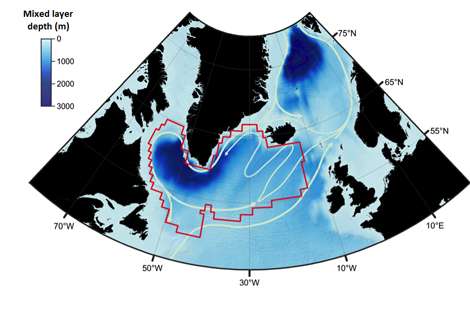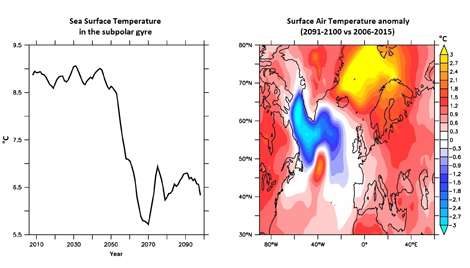Circulation in Labrador Sea, within the subpolar gyre delimited by the red line. Credit: Giovanni Sgubin—EPOC
The possibility of major climate change in the Atlantic region has long been recognized and has even been the subject of a Hollywood movie: The Day After Tomorrow. To evaluate the risk of such climate change, researchers from the Environnements et Paléoenvironnements Océaniques et Continentaux laboratory (CNRS/University of Bordeaux) and the University of Southampton developed a new algorithm to analyze the 40 climate models considered by the latest report from the Intergovernmental Panel on Climate Change (IPCC). Their findings raise the probability of rapid North Atlantic cooling during this century to nearly 50%. Nature Communications publishes their work on February 15, 2017.
Current climate models all foresee a slowing of the meridional overturning circulation (MOC)2—the phenomenon behind the familiar Gulf Stream, which carries warmth from Florida to European shores—that could lead to a dramatic, unprecedented disruption of the climate system. In 2013, drawing on 40 climate change projections, the IPCC judged that this slowdown would occur gradually over a long period of time. The panel's findings suggested that fast cooling of the North Atlantic during this century was unlikely.
Oceanographers from the EU EMBRACE project team reexamined the 40 projections by focusing on a critical spot in the northwest North Atlantic: the Labrador Sea. The Labrador Sea is host to a convection system ultimately feeding into the ocean-wide MOC. The temperatures of its surface waters plummet in the winter, increasing their density and causing them to sink. This displaces deep waters, which bring their heat with them as they rise to the surface, preventing the formation of ice caps. To investigate this phenomenon in greater detail, the researchers developed an algorithm able to detect quick sea surface temperature variations. Their number crunching revealed that 7 of the 40 climate models they were studying predicted total shutdown of convection, leading to abrupt cooling of the Labrador Sea: by 2–3 °C over less than 10 years. This in turn would drastically lower North Atlantic coastal temperatures.
Illustration of rapid cooling in gyre predicted by a climate model. Left: Change in sea surface temperature over time. Right: Projected change in air temperature at ocean surface between beginning and end of 21st century. Credit: Giovanni Sgubin—EPOC
But is such rapid cooling a real possibility? (After all, only a handful of the models supported this projection.) To answer this question, the researchers honed in on the critical parameter triggering winter convection: ocean stratification. Indeed, 11 of the 40 models incorporated vertical variation in the density of oceanic water masses. And of these 11 models, which we may furthermore consider to be the most reliable, 5 (i.e., 45% of the models) predicted a rapid drop in North Atlantic temperatures.
These projections can one day be tested against real data from the international OSNAP project, whose teams will be anchoring scientific instruments within the subpolar gyre. If these predictions are borne out and the North Atlantic waters do cool rapidly over the coming years, climate change adaptation polices for regions bordering the North Atlantic will have to account for this phenomenon.
More information: Giovanni Sgubin et al. Abrupt cooling over the North Atlantic in modern climate models, Nature Communications (2017). DOI: 10.1038/ncomms14375
Journal information: Nature Communications
Provided by CNRS
























